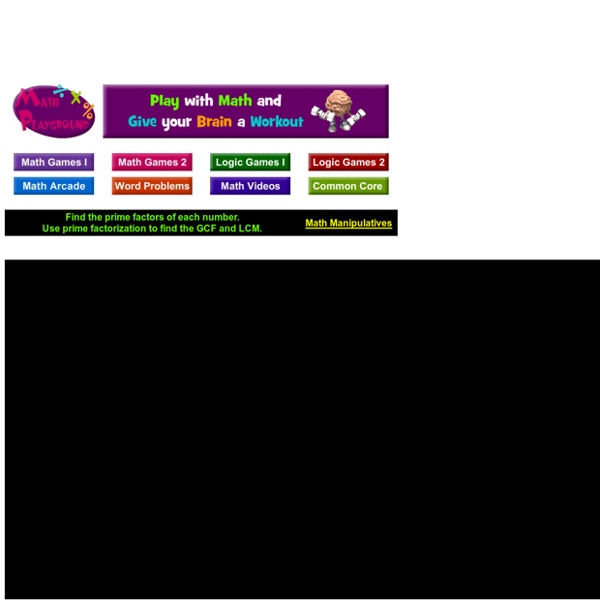



cmorsoc:: Cifra: desde la idea semilla a la tarea o proyecto ¿Preparados para una aventura con matemáticas, espías, códigos y robots? ¡Bienvenidos a Cifra! Tal y como vimos en RoboTIX, las ideas semilla son muy potentes porque pueden ser llevadas al aula siguiendo enfoques metodológicos muy diferentes: desde una perspectiva más tradicional, como trabajo de aplicación de conocimientos, a un proyecto o problema siguiendo los principios del AbP/PBL. En este caso, veremos cómo fusionar una posible introducción al mundo de la criptografía con nuestro querido amigo RoboTIX, siendo apto para cualquier nivel de ESO. Pero pasemos a ver de qué va esta aventura: Por último, aquí les paso varios ficheros de interés: Planos listos para usar: [descargar]Hoja de cálculo con tabla de códigos: [descargar]Ficheros de audio modificados: [descargar] Ya sabes, ¡la idea es hacer crecer esta semilla!
Free shape game for K-2 Want free teaching resources? Johnnie's Math Page - The Best Math for Kids and their Teachers -Hundreds of Interactive Math Tools, Math Activities, and Math Games Johnnie's Math Page is the site to find fun math for kids, math games, and even a little math homework help. Interactive math activities from across the web have been organized by topic to make math learning enjoyable and interesting. These activities have been chosen to represent the range of math learned from kindergarten to middle school. I have put together resources for middle school math. In the middle school math section you will find fantastic models for all kinds of algebra- from linear equations to quadratics. For parents and teachers, you will find math lessons and free math worksheets as well as links to other math teaching resources. For those who like a challenge, you will find free math games in the math puzzles section. Contact Johnnie
Factors and Multiples Jeopardy Game Factors and Multiples Jeopardy is a free online game for middle school students and teachers. The questions in this game focus on important concepts such as factors, multiples, prime factorization, GCF, and LCM. Important facts you should know that will help with this game. A number is divisible by its factors A number is divisible by 2 if the last digit is even. Visit this link to play other free jeopardy math games. Return from the Factors and Multiples Jeopardy game to the Middle School Math Games webpage.
Prime Factorization Prime Numbers A Prime Number can be divided evenly only by 1 or itself. And it must be a whole number greater than 1. The first few prime numbers are: 2, 3, 5, 7, 11, 13, and 17 ..., and we have a prime number chart if you need more. Factors "Factors" are the numbers you multiply together to get another number: Prime Factorization "Prime Factorization" is finding which prime numbers multiply together to make the original number. Here are some examples: Example 1: What are the prime factors of 12 ? It is best to start working from the smallest prime number, which is 2, so let's check: Yes, it divided evenly by 2. But 6 is not a prime number, so we need to go further. Yes, that worked also. As you can see, every factor is a prime number, so the answer must be right. Note: 12 = 2 × 2 × 3 can also be written using exponents as 12 = 22 × 3 Example 2: What is the prime factorization of 147 ? Can we divide 147 evenly by 2? No it can't. Let's try the next prime number, 3: (or 147 = 3 × 72 using exponents)
cmorsoc:: Pecha Kucha, Scratch y RoboTIX ¿Se acuerdan del Proyecto RoboTIX? Es una de esas ideas felices que van mejorando con el tiempo: Proyecto RoboTIX: desde la idea semilla hasta la tarea o proyectoProyecto RoboTIX (Reloaded) Este año, María López -mi súper compañera de Departamento- y yo, hemos modificado a little bit esta aventura, incorporando dos ingredientes maravillosos: Scratch, un entorno de programación que nos ha permitido crear, desde 4ºESO y tras un Scratch Day inicial, un simulador para nuestro Rug Warrior, además de multiplicar el interés y motivación del alumnado, abriéndoles las puertas del fértil mundo de la programación.Pecha Kucha, un interesante formato de presentación diseñado para sintetizar el enorme trabajo realizado por cada uno de los equipos. Y, la verdad, los resultados están siendo espectaculares...
Confronta percentuali e frazioni Un interattivo per visualizzare e confrontare percentuali e frazioni. Puoi scegliere se utilizzare la classica pizza, oppure una barretta di cioccolato. Se invece sei a dieta, ti consigliamo la brocca o le persone! Trascina numeri e percentuali sulle lavagnette e confronta i risultati. Buon Divertimento! Schermo intero Articoli che ti possono interessare Colpisci le frazioni semplificate Un classico gioco “punta e colpisci” basato sulla comprensione delle frazioni ridotte ai minimi termini. Questa volta non si deve indovinare il risultato, ma gli operandi.
Basic Facts Fluency Every math teacher struggles to find ways to encourage students to master their basic facts. Whether for addition and subtraction facts or for multiplication and division facts, teachers collect many ideas from which they can draw activities to meet the varied needs of learners in their classes. Games and Who Has? activities are especially motivational and continual play can help students develop fact fluency in an effort to master the games and capture the most points. Many teachers include a weekly "Game Day" in math classes. Math Games: Students need regular opportunities to play the games with appropriate levels of challenge and with different partners. Check out these links for Mathwire games that practice basic facts: Who Has? Once students have developed conceptual understanding of the basic operations they need to develop fluency with the facts. Check out Who Has? Teacher Resources: Check out Suggested Techniques to increase your differentiated repertoire of effective strategies.